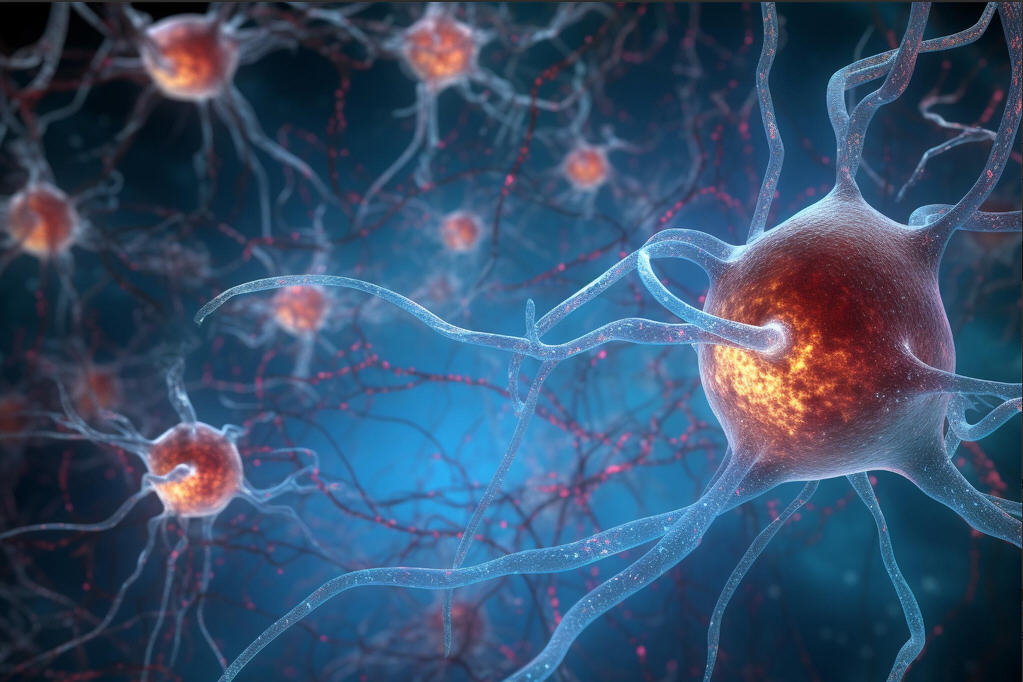博文
对160万个脑细胞的开创性研究揭开了阿尔茨海默病的奥秘
||
对160万个脑细胞的开创性研究揭开了阿尔茨海默病的奥秘
诸平
据美国纽约哥伦比亚大学欧文医学中心(Columbia University Irving Medical Center, New York, NY, USA)2024年9月8日提供的消息,对160万个脑细胞的开创性研究揭开了阿尔茨海默病的奥秘(Groundbreaking Study of 1.6 Million Brain Cells Unravels Alzheimer’s Mysteries)。
一项对160万个脑细胞的研究,揭示了阿尔茨海默氏症的早期细胞变化和干预机会,利用先进技术区分疾病进展和正常衰老。
一项对来自老年人的160多万个脑细胞的分析发现,在老年痴呆症的早期阶段,细胞发生了变化。这些发现可能会揭示预防老年人痴呆症最常见原因的新策略。该研究还发现了第二种细胞群落,这种细胞使老年大脑走上不同的道路,而不会导致阿尔茨海默病(Alzheimer’s disease)。相关研究结果于2024年8月28已经在《自然》(Nature)杂志网站在线发表——Gilad Sahar Green, Masashi Fujita, Hyun-Sik Yang, Mariko Taga, Anael Cain, Cristin McCabe, Natacha Comandante-Lou, Charles C. White, Anna K. Schmidtner, Lu Zeng, Alina Sigalov, Yangling Wang, Aviv Regev, Hans-Ulrich Klein, Vilas Menon, David A. Bennett, Naomi Habib, Philip L. De Jager. Cellular communities reveal trajectories of brain ageing and Alzheimer’s disease. Nature, 28 August 2024, DOI: 10.1038/s41586-024-07871-6
参与此项研究的有来自以色列耶路撒冷希伯来大学(The Hebrew University of Jerusalem, Jerusalem, Israel)、美国纽约哥伦比亚大学欧文医学中心(Columbia University Irving Medical Center, New York, NY, USA)、美国波士顿哈佛医学院(Harvard Medical School, Boston, MA, USA)、美国麻省理工学院和哈佛大学的布罗德研究所(Broad Institute of MIT and Harvard, Cambridge, MA, USA)、美国波士顿的布里格姆妇女医院(Brigham and Women’s Hospital, Boston, MA, USA)、美国芝加哥的拉什大学医学中心(Rush University Medical Center, Chicago, IL, USA)以及美国麻省理工学院科赫综合癌症研究所(Koch Institute of Integrative Cancer Research, Massachusetts Institute of Technology, Cambridge, MA, USA)的研究人员。
哥伦比亚大学神经学家菲利普·德耶格(Philip De Jager)与哥伦比亚大学瓦格洛斯内科和外科医学院(Columbia University Vagelos College of Physicians and Surgeons)神经科学助理教授维拉斯·梅农(Vilas Menon)和耶路撒冷希伯来大学的内奥米· 哈比卜(Naomi Habib)共同领导了这项研究。
菲利普·德耶格说:“我们的研究强调,阿尔茨海默氏症是许多细胞及其相互作用的疾病,而不仅仅是一种功能失调的细胞。我们可能需要修改细胞群落以保持认知功能,我们的研究揭示了导致阿尔茨海默氏症的事件序列中的一些点,我们可能能够进行干预。”
处理160万个脑细胞的数据(Crunching data from 1.6 million brain cells)
这项研究是一个技术奇迹,巧妙地结合了新的分子技术、机器学习技术和大量老年人捐赠的大脑。
虽然之前对阿尔茨海默氏症患者大脑样本的研究提供了与该疾病有关的分子的见解,但它们并没有揭示在导致阿尔茨海默氏症的一系列事件中,这些基因在哪里起作用,以及在这个过程的每一步都有哪些细胞参与。
菲利普·德耶格说:“过去的研究分析的是整个大脑样本,但它们失去了所有细胞的细节。我们现在有工具可以在单个细胞的水平上更精细地观察大脑。当我们将这些信息与大脑捐赠者在死亡前的认知状态的详细信息结合起来时,我们可以从疾病的早期阶段重建大脑衰老的轨迹。”
新的分析需要400多个大脑,这些大脑是由宗教团体研究(Religious Orders Study)和芝加哥拉什大学的记忆与衰老项目(Memory & Aging Project based at Rush University in Chicago)所提供的。
在每个大脑中,研究人员从受阿尔茨海默病和衰老影响的大脑区域收集了数千个细胞。然后对每个细胞进行单细胞RNA测序,读出细胞的活性和哪些基因是活跃的。
然后通过维拉斯·梅农和内奥米· 哈比卜开发的算法和机器学习技术分析所有160万个细胞的数据,以确定样本中存在的细胞类型及其与其他细胞的相互作用。
维拉斯·梅农说:“这些方法使我们对导致大脑功能改变和认知障碍的潜在分子事件序列有了新的认识。多亏了大量的脑供体和细胞,该团队有幸从中获得数据,这才成为可能。”
衰老与老年痴呆症(Aging vs. Alzheimer’s)
由于这些大脑来自患病过程中不同阶段的人,研究人员能够解决阿尔茨海默病研究中的一个主要挑战:确定与阿尔茨海默病有关的细胞变化的顺序,并将这些变化与正常大脑衰老相关的变化区分开来。
菲利普·德耶格说:“我们认为,两种不同类型的小胶质细胞(microglial cells)——大脑的免疫细胞——开始了淀粉样蛋白和tau蛋白积累的过程,这是阿尔茨海默病的特征。”
在病理积累之后,被称为星形胶质细胞(astrocytes)的不同细胞在改变大脑中的电连接方面起着关键作用,从而导致认知障碍。这些细胞相互交流,并带来额外的细胞类型,从而严重破坏人类大脑的功能。
菲利普·德耶格说:“这些令人兴奋的新发现可以指导阿尔茨海默病和大脑衰老的创新治疗开发。通过了解单个细胞如何对疾病的不同阶段做出贡献,我们将知道减少每个个体中致病细胞群落活动的最佳方法,使脑细胞恢复到健康状态。”
该研究由美国国立卫生研究院(National Institutes of Health:NIH RF1 AG057473, U01 AG061356, U01 AG046152, R01 AG070438, R01 AG015819, U01 AG072572, R01AG066831; NIH K23 AG062750; NIH NIA K23AG062750; NIH NIA R01AG080667; CS-02018-191971)、陈-扎克伯格倡议(Chan Zuckerberg Initiative)、以色列科学基金会{Israel Science Foundation (ISF) research grant no. 1709/19}、欧洲研究理事会(European Research Council grant 853409)、中国科技部(Chinese Ministry of Science and Technology MOST-IL-China research grant no. 3-15687)、迈尔斯基金会(Myers Foundation)和阿尔茨海默氏症协会{An Alzheimer’s Association Grant through the AD Strategic Fund (ADSF-21-816675)}的资助。
上述介绍,仅供参考。欲了解更多信息,敬请注意浏览原文或者相关报道。
Alzheimer’s disease (AD) has recently been associated with diverse cell states1,2,3,4,5,6,7,8,9,10,11, yet when and how these states affect the onset of AD remains unclear. Here we used a data-driven approach to reconstruct the dynamics of the brain’s cellular environment and identified a trajectory leading to AD that is distinct from other ageing-related effects. First, we built a comprehensive cell atlas of the aged prefrontal cortex from 1.65 million single-nucleus RNA-sequencing profiles sampled from 437 older individuals, and identified specific glial and neuronal subpopulations associated with AD-related traits. Causal modelling then prioritized two distinct lipid-associated microglial subpopulations—one drives amyloid-β proteinopathy while the other mediates the effect of amyloid-β on tau proteinopathy—as well as an astrocyte subpopulation that mediates the effect of tau on cognitive decline. To model the dynamics of cellular environments, we devised the BEYOND methodology, which identified two distinct trajectories of brain ageing, each defined by coordinated progressive changes in certain cellular communities that lead to (1) AD dementia or (2) alternative brain ageing. Thus, we provide a cellular foundation for a new perspective on AD pathophysiology that informs personalized therapeutic development, targeting different cellular communities for individuals on the path to AD or to alternative brain ageing.
https://blog.sciencenet.cn/blog-212210-1450209.html
上一篇:激素悖论:睾酮如何同时助长和抑制癌症
下一篇:打破稳定性障碍:独特的同位素违反核规则
